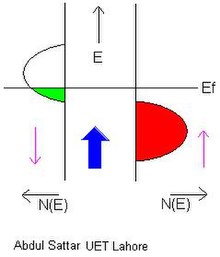
A half-metal is any substance that acts as a conductor to electrons of one spin orientation, but as an insulator or semiconductor to those of the opposite orientation. Although all half-metals are ferromagnetic (or ferrimagnetic), most ferromagnets are not half-metals. Many of the known examples of half-metals are oxides, sulfides, or Heusler alloys. Types of half-metallic compounds theoretically predicted so far include some Heusler alloys, such as Co2FeSi, NiMnSb, and PtMnSb; some Si-containing half–Heusler alloys with Curie temperatures over 600 K, such as NiCrSi and PdCrSi; some transition-metal oxides, including rutile structured CrO2; some perovskites, such as LaMnO3 and SeMnO3; and a few more simply structured zincblende (ZB) compounds, including CrAs and superlattices. NiMnSb and CrO2 have been experimentally determined to be half-metals at very low temperatures.
In half-metals, the valence band for one spin orientation is partially filled while there is a gap in the density of states for the other spin orientation. This results in conducting behavior for only electrons in the first spin orientation. In some half-metals, the majority spin channel is the conducting one while in others the minority channel is.
Half-metals were first described in 1983, as an explanation for the electrical properties of manganese-based Heusler alloys.
Some notable half-metals are chromium(IV) oxide, magnetite, and lanthanum strontium manganite (LSMO), as well as chromium arsenide. Half-metals have attracted some interest for their potential use in spintronics.
References
- ^ Coey, J.M.D.; Venkatesan, M. (2002). "Half-metallic ferromagnetism: Example of CrO2". Journal of Applied Physics. 91 (10): 8345–50. Bibcode:2002JAP....91.8345C. doi:10.1063/1.1447879.
- Rostami, Mohammad; Afkani, Mohammad; Torkamani, Mohammad Reza; Kanjouri, Faramarz (2020-07-01). "Bulk and surface DFT investigations of the electronic and magnetic properties of CsXNO (X = Mg, Ca and Sr) quaternary Heusler alloys". Materials Chemistry and Physics. 248: 122923. doi:10.1016/j.matchemphys.2020.122923. ISSN 0254-0584.
- de Groot, R. A.; Mueller, F. M.; Engen, P. G. van; Buschow, K. H. J. (20 June 1983). "New Class of Materials: Half-Metallic Ferromagnets" (PDF). Physical Review Letters. 50 (25): 2024–2027. Bibcode:1983PhRvL..50.2024D. doi:10.1103/PhysRevLett.50.2024. hdl:11370/e3946f6b-8acb-4e0a-80cf-735506203f25.
Further reading
- Guezlane, M; Baaziz, H; El Haj Hassan, F; Charifi, Z; Djaballah, Y (2016). "Electronic, magnetic and thermal properties of Co2CrxFe1−xX (X=Al, Si) Heusler alloys: First-principles calculations". Journal of Magnetism and Magnetic Materials. 414: 219–26. Bibcode:2016JMMM..414..219G. doi:10.1016/j.jmmm.2016.04.056.
- Son, Young-Woo; Cohen, Marvin L; Louie, Steven G (2006). "Half-metallic graphene nanoribbons". Nature. 444 (7117): 347–9. arXiv:cond-mat/0611600. Bibcode:2006Natur.444..347S. doi:10.1038/nature05180. PMID 17108960. S2CID 52851642.
- http://www-users.york.ac.uk/~ah566/research/half_metals.html
- http://www.tcd.ie/Physics/People/Michael.Coey/oxsen/newsletter/january98/halfmeta.htm
This condensed matter physics-related article is a stub. You can help Misplaced Pages by expanding it. |
 is the
is the  is the
is the